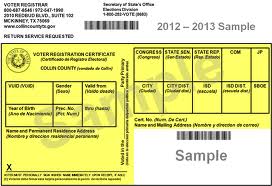You really have to read this.
The confusion started in the first hour of the first day of early voting in San Antonio last October.
Signs in polling places about the state’s controversial voter ID law contained outdated rules. Poll workers gave voters incorrect information. Lines were long — full of people who were full of uncertainty.
The presidential election of 2016 was off to a sputtering start in Texas, where years of angry claims about illegal voting had led to a toughening of identification requirements for those going to the polls.
On that day last October, Nina Perales, vice president of litigation for the Mexican American Legal Defense and Education Fund, was met with a line out the door when she arrived at her San Antonio polling place.
“A poll worker stood in front of me where I was and said, ‘You are at the one-and-a-half-hour mark,'” Perales said. “And she insisted your ID needed to be out when you got to the front of the line.”
But that, in fact, wasn’t the law. A compromise a federal court had settled on months before allowed those without photo IDs to fill out an affidavit and show alternate ID.
“So, we filed suit against the county,” Perales said.
Days later, Bexar County, home to San Antonio, agreed to try and remedy its mistakes — poll workers would be retrained, signs would be corrected and voicemail instructions for voters would be updated.
But a ProPublica review of the 2016 vote in Texas shows that Bexar County’s problems were hardly isolated — and, in many cases, were beyond fixing.
Indeed, the state’s efforts to enact and enforce the strictest voter ID law in the nation were so plagued by delays, revisions, court interventions and inadequate education that the casting of ballots was inevitably troubled. Among the problems that surfaced:
- The promised statewide effort to inform Texans about voter identification requirements failed terribly. ProPublica contacted hundreds of community organizations and local county party officials to see if they’d received a voting instruction manual the state said it had sent but could not find one who had used it. The largest voter education groups — League of Women Voters Texas, the Southwest Voter Registration Education Project, MALDEF and several disability rights groups — said they didn’t get copies at all.
- The fiscal note attached to the 2011 bill indicated voter education would cost the state $2 million. That’s one-fifth what a similar bill in Missouri — a state with 21 million fewer people than Texas — allocated. While the Texas secretary of state’s office spent the majority of its voter education budget in 2016 to educate voters about the law, the money appears to have been wasted on an ineffective campaign.
- The Texas Department of Public Safety, a law enforcement agency tasked with issuing free IDs for voting purposes, initially required those who applied for the ID to be fingerprinted, a decision many say scared off potential voters. DPS also didn’t have Spanish translators in all of its offices and didn’t initially provide applications or information about the free IDs in any language other than English.
- Remarkably, the very aim of the legislation — to thwart people from voting illegally — was not fully addressed by the law, which allowed three versions of identification obtainable by non-citizens.
Jacquelyn Callanen, the election administrator for Bexar County, said she is still furious about the state’s performance in handling last November’s vote.
“I’ve been doing this for 22 years,” she said. “This was the most complicated and emotionally charged election I have ever seen.”
There’s a ton more, and you need to read the whole thing. It will piss you off, and it should. We know that the state’s so-called voter ID education effort last year was a boondoggle and a failure, but you can’t fully appreciate how big a failure it was without this. Among other things, the story recounts the history of voter ID legislation in Texas, how the Elections department at the Secretary of State’s office became politicized and denuded of competence, and more. As noted by the Brennan Center, there will be a status call on June 7 to sort out the issues in determining a remedy in the wake of the ruling last month that the voter ID law was passed with discriminatory intent. I say any such remedy needs to begin with a complete scrapping of the existing law and an eight-figure campaign to do real voter (and elections administrator) education, done by multiple firms that don’t make BS claims about “proprietary” information. Then maybe, just maybe, we can claim to have set things right. Read the story and see what I mean.


Pathetic lying GOP about voter fraud in the first place.
And then their cluster****ing of the process afterwards to further their dishonesty.
The GOP make me sick in what they are doing.
Those in the know – like Red – know that the real voter hanky-panky occurs with the mail-in ballots. That’s where the action is. In person voter fraud is effectively non-existent.